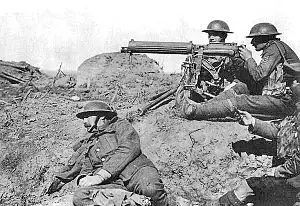Changes in Warfare
World War I made many changes to modern warfare that are still in use today. Before “The Great War,” individual countries fought each other for territory or resources. This kept wars small and localized. Prior to WWI, soldiers battled one another on the ground or at sea. Soldiers with guns were the primary method used to fight battles. Armored vehicles attacked walls and protect generals, not common soldiers. But World War I changed not only why, but how countries went to war and prepared to defend themselves.


War was not new. There had been war since one tribe of our ancient ancestors decided they wanted something another tribe used. Throughout the centuries, countries went to war against one another. But the battles were local. Other countries generally kept out of the fray. Occasionally one country may ask for or hire help from a mutual enemy. For example, during the Revolutionary War when the new United States asked for soldiers and ships from France. France agreed since it was a mutual enemy of the British. What made World War I different were the treaties that countries had forged in the years before the war. So when an Austrian Prince was killed in July of 1914, what might have been a local event turned into a global war.
When an assassin killed Archduke Ferdinand, he set into effect treaties that began the war. The assassin was Serbian, part of a country that the Russian Tsar protected. The Archduke was Austrian. So this brought Austria and Russia into conflict. As both sides escalated, or fought harder, they brought in their allies. Austria called in Germany and Italy, while Russia asked France and Great Britain for help. Each of these countries looked to their allies and colonies for men and supplies. So that brought Canada, Turkey, Morocco and other small countries into the fray. Never, in the history of the planet, had so many countries fought in a single war.

Soldiers fought this war differently than other wars. Rather than shooting at each other from formal lines, or even from behind sandbags, soldiers in WWI fought the war from trenches. These were more than just holes in the ground. Trenches were four to six feet wide and eight to ten feet deep. These trenches would connect with other earthworks to form trench complexes many miles long. These trenches kept soldiers out of view. So the enemy had no way of knowing whether there were just a few soldiers in the trench or hundreds.
Trenches kept armies apart. No one was able to win and no one wanted to quit. Both sides worked on ways to get across enemy lines to win the war. Tanks made a big impact. WWI saw a big change in tanks. They became longer, long enough to actually drive over the trenches without falling in. They were also heavy enough to collapse the sides, clearing a path for cars, trucks and even horses.

But before armies could send in tanks, they had to know what the other was doing. Soldiers couldn’t sneak across the trenches to spy on enemy movement. A new way of fighting required a new way of spying. If spies couldn’t go through enemy lines, they would have to go over them. Before World War I, airplanes were a novelty. They were small, seating only one person. They couldn’t carry cargo or people like modern airplanes. But soon airplanes were flying over trenches and bringing back information about soldiers and supply lines. As military on both sides worked, airplanes became flying weapons. Soldiers learned to fire machine guns and even drop bombs while flying through the air.
World War I also saw a change in how armies used bombs. Before the Great War, bombs simply exploded. They caused damage through the explosion and shrapnel, small pieces of metal, that would hurt enemy soldiers. Trenches prevented a lot of bomb damage. Armies quickly learned to dig trenches that turned corners to protect soldiers from the blasts. Armies began to look for new ways to use bombs. They developed bombs that help mustard gas. These bombs wouldn’t cause a lot of damage when they exploded. Instead, they would release mustard gas that would move through the trenches killing soldiers that breathed the gas.

Many of the changes that WWI brought to fighting are still in use today. Pilots still use airplanes and even satellites to spy on other countries. Tanks still help soldiers get across enemy lines safely and Countries still have alliances with other nations..



